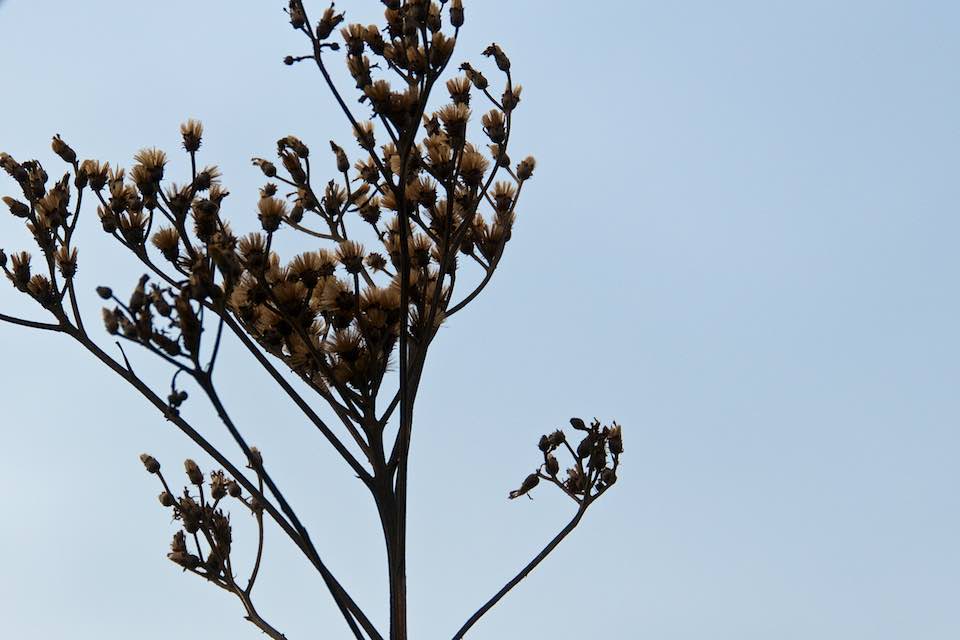When I first heard his prairie-ness Piet Oudolf say ‘I love plants that are dead’, I thought that the good man had sniffed one too many perennials. As ever, he is quite right. There is true beauty in decay. For some gardeners, dead and decaying plants may just look as tired as Donald Trump’s coiffure and simply doomed for a drastic hair cut. However, there are so many plants that die so beautifully that an element of mortality should be designed into our planting schemes.
As gardeners, we spend every waking moment enlivening our gardens into vibrant, zestful green spaces, brimming with life and colour. Despite our earnest efforts, plants do spend much of their lifecycle decaying into dormancy. This need not be a bad thing though. Where once I fretted feverishly over spent brown bits peaking through the border, my outlook has changed. Gardening is now very much an appreciation of plants, throughout their entire lifecycle, where the focus is not solely on their flowers.
Admittedly, this isn’t just about aesthetics. Allowing plants to just do their thing, without the need for (much) intervention is simply practical. Liberating almost. Packed herbaceous borders are pretty much impenetrable to anything in wellies. If I can avoid having to tread and do damage, that’s a real bonus.
Designing mortality
Designing herbaceous borders that allow, enhance and brandish the natural processes of growth right through from birth to death and the ‘after-life’, is unfortunately quite complicated.

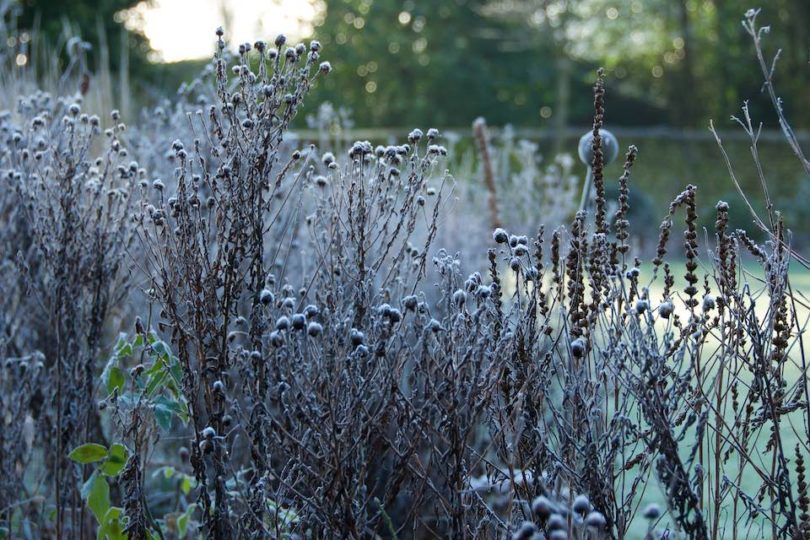
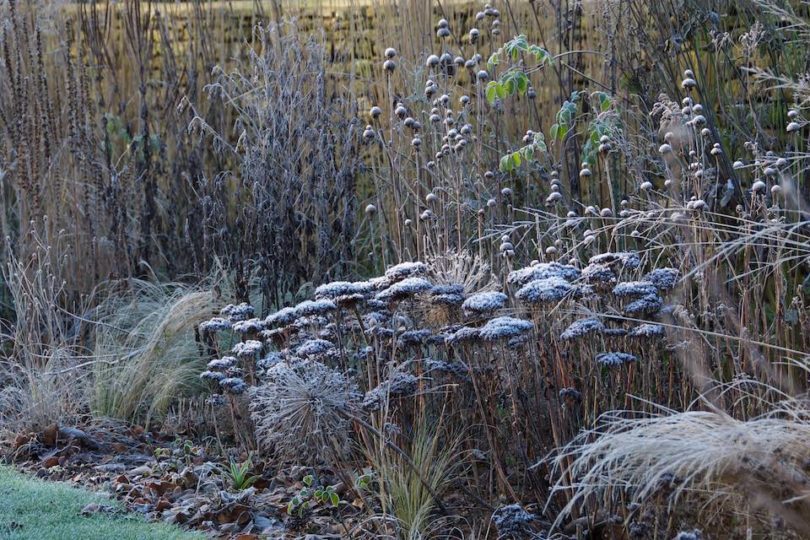
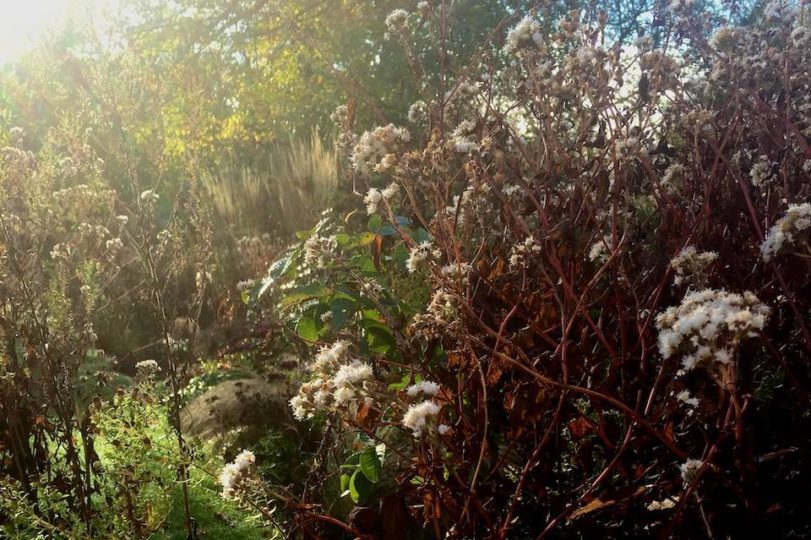
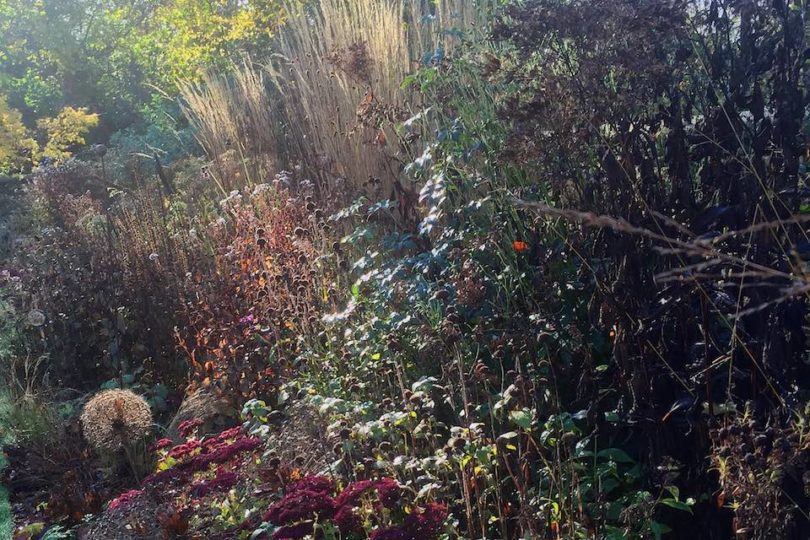

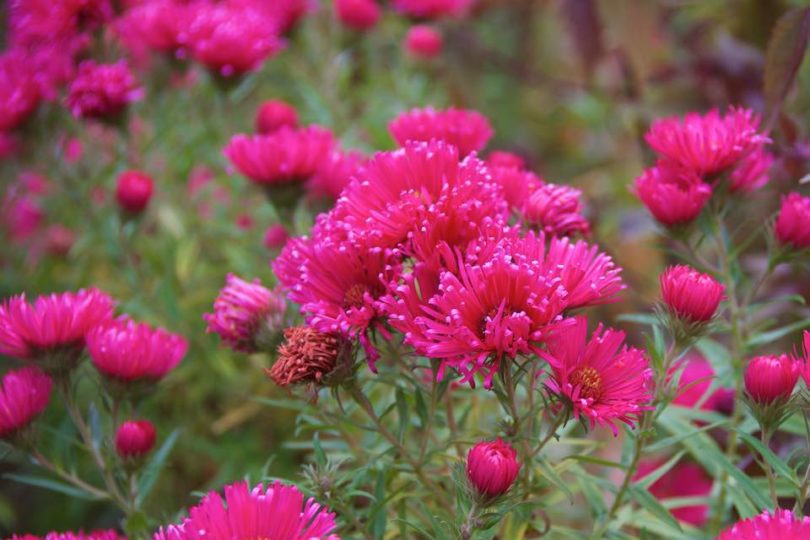
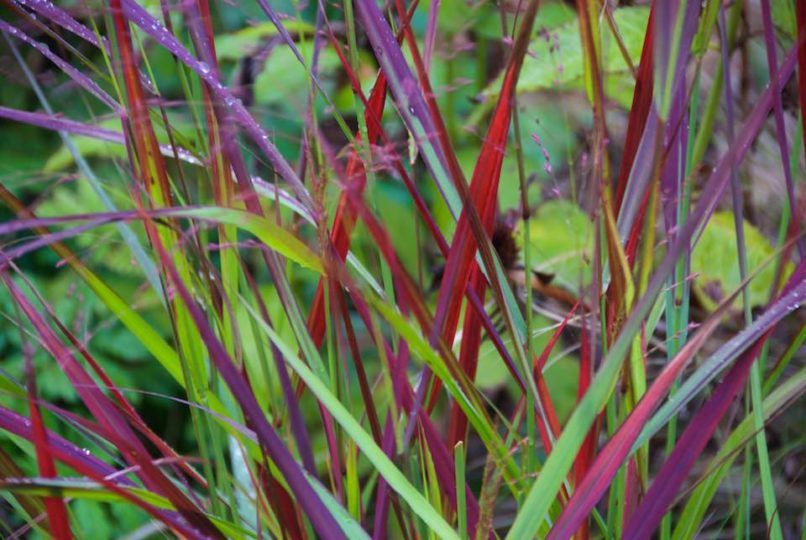

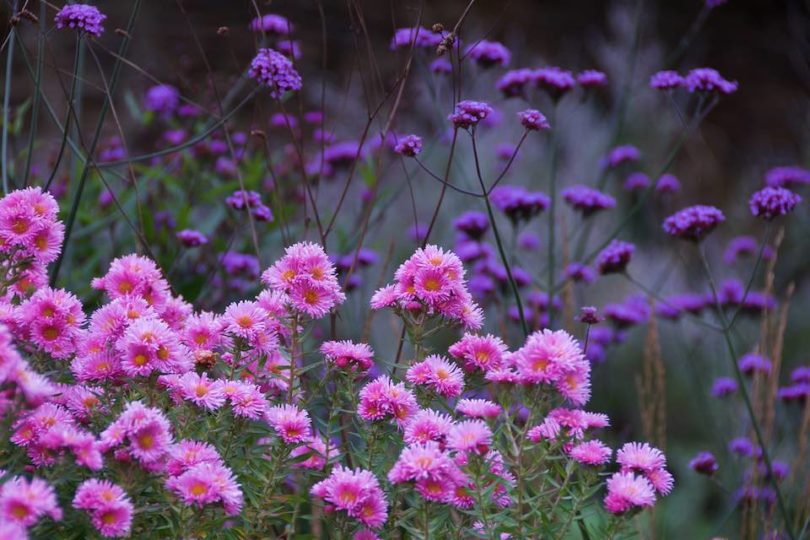





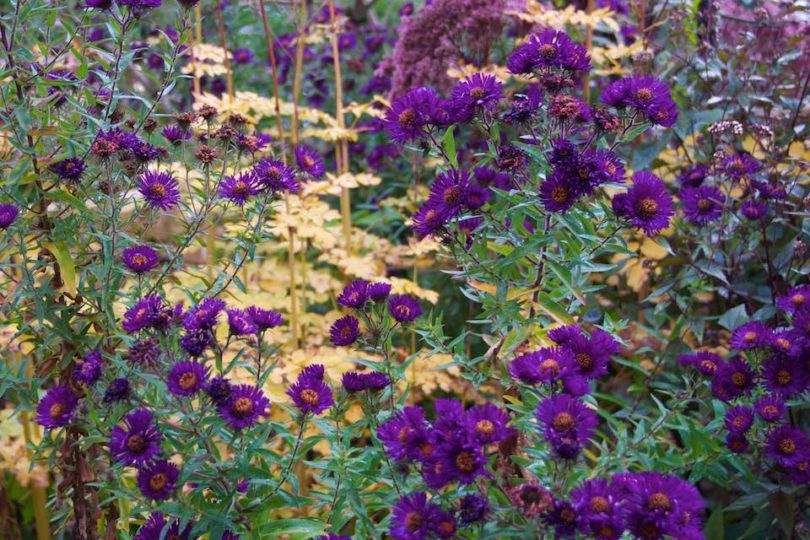
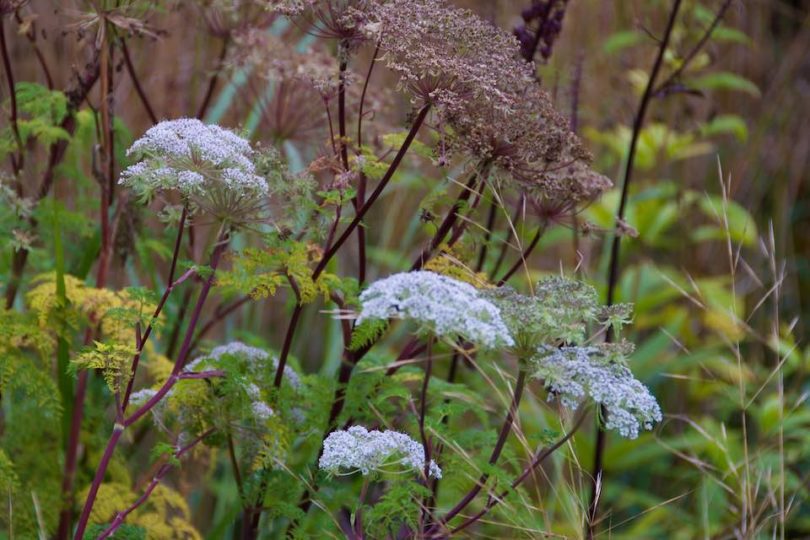


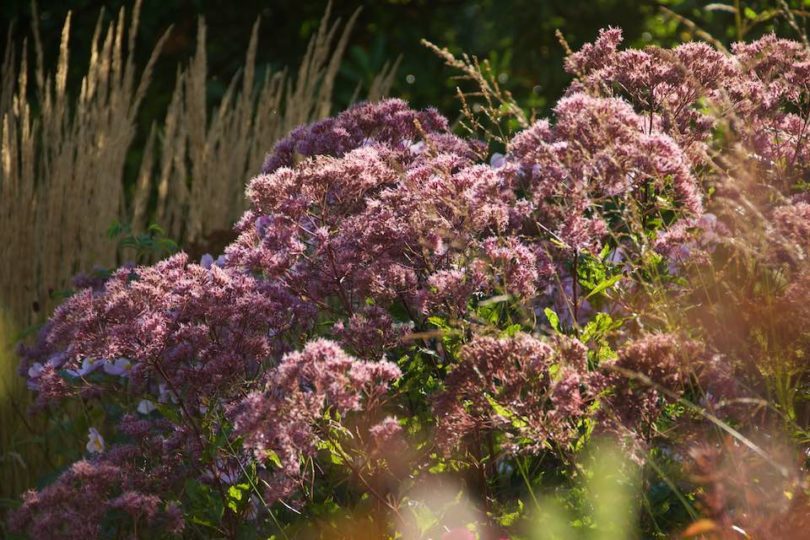

For starters one must resist the urge to blindly chop. Then, plant choices must include those that not only fit your spring, summer and autumn planting schemes, but mature elegantly throughout the seasons. If that wasn’t complicated enough, one also needs to take into account how those plants mature to ensure their waning predicament still works for your herbaceous border – throughout the seasons.
Unless you’re a prairie genius, I’m afraid that trial and error has proved the best approach to my elegiac planting. However, here are a few tips I have learned along the way.
To chop or not to chop?
Admittedly decay is not always elegant. Some plants will simply collapse into a mushy slush, which is no thing of beauty. Where space allows though, such vegetal dieback is just to be accepted as natural, and certainly doesn’t have to be ugly. That being said, trust your instincts. If it just looks like a large brown albatross to you, cut it down. We have made our herbaceous as wide and deep as possible, which means we can get away with the odd albatross and, any other death deficiencies. In more visible areas, such as the narrow parts of the border, or the front of the border, I do tweak where needed.
Blend blend blend
A big mass of everything is key. Combine tall spikes with bushy skeletons, grassy backdrops, varying colours and textures, include bobbly seed heads with attractive foliage and stems. Repeating this planting throughout the border further enhances the look.
Dead duracell bunnies
Consider how long something will look good dead. Not easy, as this depends both on the weather, the plant and it’s lifecycle.
Spring flowering plants, such as alliums for example will be decaying as the rest of the borders gears up for their summer display. The same applies to plants that flower early in summer and decay whilst the rest of the border gears up for the late summer/autumn display. Where the blanched monopolises, I carefully tweak. Gentle being the operative word, as you need to bear in mind their value to the winter garden. Again, just use your canny gardening instincts.
In the winter garden, some plants are better performers. My favourites of which, I have listed below. Thalictrum Elin for example is delightful in autumn and early winter, but rather fragile and much prone to wind damage. One of my favourite grasses, a moor grass; Molinia caerulea subsp. arundinacea ‘Karl Foerster’, looks lovely in winter but is fragile too and falls apart quite early. The endless, heavy and consistent rain we’ve been having, has unfortunately speeded up that process. My poor Karl is now very much down on the ground, so pretty much destined for the compost bin. If weather conditions were perfect, Karl should be upright until about January. As a precaution to Karl’s possible lacklustre performances, I have planted a sturdy perennial neighbour (Eupatorium maculatum) to pick up the slack. Thank you Herr Eupatorium.
Don’t forget the drama
Practical, slow elegant decayers shouldn’t only feature. Sudden, dramatic deaths should also be part of the garden. Echinacea for example look wonderful, but come the first frost their seed heads break apart promptly. Similarly, Lychnis coronaria produce a wonderful bleached straw colour framework of beautiful seed heads. The stems are however so delicate that with just a gush of wind, or rain they collapse quickly. Their dramatic exit, be it short lived is however much valued and I wouldn’t do without them. As a bonus, they look rather good alive too….
Plants that die nicely
Experience has resulted in varied cabinet of threnodial plant curiosities, some of which I listed here for your perusal. I am always open to other suggestions, so by all means do make use of the now sadly bygone, – social media surpassed and victim of ‘Like’ button inertia – comment box below…
Eupatorium maculatum Atropurpureum
6ft stately plant, 3-9 months of structural interest. At their peak: fluffy purple-pinky flowers. Leaves are a deep dark green, lance shaped and serrated at the edge. The purple stems are strong and sturdy, so no need to stake. Strong enough to hold up perennial neighbours. Autumn: Good autumn colour. Flowers bleach down to a soft brown. Stems strong enough to withstand heavy winds. In winter: strong elegant winter skeleton, flowers drop to reveal striking umbel.
Ageratina altissima ‘Chocolate’ (syn. Eupatorium)
Real workhorse of plant, 3-9 months interest. At their peak: striking purple foliage. Autumn: Last to flower. Small fluffy white ball like flowers. In winter: Strong upright skeleton. Dark brown.
Veronia crinita Mammuth
One of my favourites, and the tallest plants in the borders. Can tower up to 8-10ft depending on soil. 3-9 months of interest. At their peak: tall, very sturdy with clusters of dark purple flowers. The flowers resemble those of asters with their slightly open buds – vernonias are members of the Asteraceae family. In winter: Tallest, strong elegant winter skeleton, flowers drop to reveal striking umbel. I love their height, piercing though the border, leaving everything else behind. Note: Susceptible to slugs in the spring. Slow to form a good clump.
You say potato, I thought it was Aster, but now it’s…Symphyotrichum
Good all rounder plants. Before their peak: superb green backdrop in the borders. 3-9 months of interest (depending on cultivar). At their peak: masses of small daisies from late summer to mid-autumn. Favourites include; Symphyotrichum novae-angliae ‘Harrington’s Pink’, Symphyotrichum novae-angliae ‘Violetta’, Symphyotrichum Ericoides ‘Sulphurea’, Symphyotrichum cordifolium ‘Silver Spray’, Symphyotrichum novae-angliae ‘Andenken an Alma Pötschke’. In winter: mass of small seed heads on coppery brown, bushy skeletons. Note: Need staking, especially if it’s to be part of the winter garden display.
Boltonia asteroides var.latisquama
The ‘false’ aster, 5-6 feet tall (depending on soil type) and approximately 3-9 months of interest. At their peak: Bursting with tiny, daisy-like flowers in late summer to mid-autumn. The flowers are camomile like, with typically white rays with yellow centres, but distinctly pink-tinged. In winter: mass of small seed heads on coppery brown, bushy skeletons. Note: Don’t be fooled by it’s appearance of strength. Definitely needs staking. I have heard that the Chelsea chop could reduce that requirement, but have yet to experiment.
Grasses
Too many to list here unfortunately. Hence kept it to a handful of favourites.
- Panicum virgatum ‘Rehbraun’. Upright green, deciduous spiked leaves which come autumn turn a rich reddish purple. Slow to form good clumps, probably on account of our wet soil. In winter great verticality, coppery tones with seed heads that resemble branches of seeding willow tree.
- Calamagrostis × acutiflora ‘Karl Foerster’. By far one of most beautiful grasses, very stiff, erect and forms a wonderful feathery screen. Comes up earlier than most grasses in spring. At its peak: tidy vertical habit and beautiful feathery blooms. In winter: narrow plumes of golden straw, that last well into the new year.
- Molinia caerulea subsp. arundinacea ‘Karl Foerster’. Tall purple moor grass has great golden brown flowering spikes, which come autumn turn a superb butter yellow. Very fragile, come January most of the spikes will have fallen over. Note: Very slow mover in spring.
- Stipa tenuissima. Very fine, deciduous grass to 60cm, which forms a compact upright tuft of thread-like leaves, with feathery flowering panicles. At least 9+months of interest. Matures to a bleached blonde in winter, which despite its fine form is pretty resistant to rain and wind.
- Deschampsia cepitosa. At peak: cloud of dainty silver-tinted, purple spikelets in summer which lasts well into autumn. In winter bleaches down to a soft fawny brown mass of candy floss. Note: tad promiscuous as it will self seed.
Actaea simplex Atropurpurea Group
Striking dark purple leaved perennial, growing to 1.2m. 3-9 months of interest. At their peak: clumps of dark purple foliage with long tapered bottlebrush pinkish white flowers end of summer/early autumn. In winter: flowers revert to striking seed head spikes which last throughout the winter.
Lythrum salicaria
At least 3-9 months interest. At their peak: striking narrow spikes of pinky purple flowers. The native loosestrife is a favourite, though self seeds. Other good cultivars include; ‘Zigeunerblut’ and the pale-pink ‘Blush’ which both reach 1.2m. Good autumn colour. In winter: Strong upright poker shaped seed heads which adds real character to the winter garden.
Thalictrum Elin
A plant I will not be without. At least 9 months of interest, as is an early riser in spring. At their peak: glaucous green foliage with a haze of dusky lavender-pink flowers on 2.5m heigh stems. No need to stake if in a sunny position. In autumn: Striking yellow colour. In winter: Fragile, but if in a protected position can last through the winter. Tall fawny stems, topped with delicate umbel skeletons.
Sedum Autumn Joy/Herbstfraude
One of the stars of the winter garden. Herbstfraude is one of the sturdiest winter performers. 9+ months interest. At their peak: Succulent, glaucous green leaves, topped with salmon pink flowers in summer. Flowers mature to rich coppery red in autumn. In winter: sturdy plant, capable of taking some snow. Flowers darken to a deep brown and with their flat topped flowers, they look almost like miniature Acacia trees. Usually last well into the new year.
Phlomis tuberosa ‘Amazone’
Superb plant. 9+ months of interest. At their peak: whorls of tubular, fluffy lilac flowers appear at intervals on erect stems held high above downy leaves. Flowers fade quite early in summer but continue to provide interest through their architectural seed heads. In winter these seed heads really come into their own, especially when covered with frost. The same goes for its space encroaching cousin, Phlomis russeliana.
Monarda hybrids
Deliciously scented, long flowering plant. 3-9 months interest. At their peak: tight whorls of narrow-petalled flowers spaced at regular intervals on a stout stem with aromatic leaves. Preferred cultivars; Beauty of Cobham, Raspberry Wine and Scorpion. In autumn: Sturdy stems pierce the round seed heads through the undergrowth which last right through winter, even after a snow fall. Note: unfortunately rather unpredictable in terms of its hardiness.
Veronicastrum virginicum
Structural asset in the garden. 9 months of interest. At their peak: Long, narrow, tapering spiked flowers from July to September above whorls of deep green leaves. In autumn: strong habit, the upright finger like flowers fade to warm rusty browns which persist in winter. Provides great tall, contrast and silhouette in the winter border.
References
- Piet Oudolf & Noel Kingsbury, Planting: A new perspective, Timberpress, 2013
